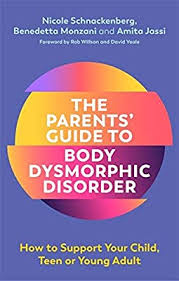Help and Advice for Parents
It can be very scary when your child is showing signs of BDD and it can be hard to know how to help. We are here to try and help guide you through the process of supporting your child and getting them the right help.
Recognising there is a problem
It can often be tricky with teenagers to know if appearance concerns are a ‘normal’ part of being an adolescent or whether it is BDD. The biggest give-away is if the preoccupation with their appearance and associated behaviours cause them significant distress and interfere with their life. Feelings and Symptoms >
For example, they may often be late to or avoid school and events because of appearance concerns and/or because of extensive rituals they need to carry out before leaving the home. There may be other signs, such as avoiding activities that they were previously engaged with, constantly seeking reassurance about the way they look, and examining others’ appearance and comparing this to their own.
If you suspect your child has BDD, it is essential that you share this with them in a calm and non-judgemental way. Avoiding getting into a discussion about the content of your child’s appearance concerns is important and it will be more helpful instead focus on the distress and interference these concerns are causing. Sharing with them that you know they are not being vain and that you understand they are distressed because of their worries can be a really helpful.
You may wish to share the information on this website to support your discussion and see if they can relate to anything that has been described.
- Watching the animation on the homepage
- Reading through the section titled ‘What is BDD’.
- You may also wish to see our ‘Family and Friends’ page which offers further suggestions on how to navigate discussions around appearance concerns as well as helpful ways of responding to BDD.
We also have our Youth website which has lots of resources and videos for young people and parents.
Your child may be relieved that this has been recognised as a problem or they may not see it as BDD. It is essential that you keep emphasising the distress and interference aspects of BDD and that there is help to manage their distress. You can give them information on treatment and support to help them understand what is on offer (see ‘Treatment for BDD’).
If your child demonstrates any risk issues such as suicidal thoughts or self-harm, it is important you seek mental health support immediately.
Getting help
If your child is unsure about seeking support, you can approach your primary care physician (e.g. GP) or a mental health service to raise your concerns. Services available on the NHS in the UK >
Share with the practitioner that you suspect your child has BDD and discuss a way forward with them in how to support your child to get treatment. You can use this GP card to help you. Ideally, your child should join you to seek support, but if not, do not let that stop you from sharing your concerns with a professional. Your child should be offered a mental health assessment following which treatment options should be explored.
It is crucial that BDD is explored as one possible diagnosis as clinicians can often mistake symptoms for other difficulties (i.e., Depression, Social Anxiety or an Eating Disorder) due to the overlap across these conditions. It may be helpful to take information from this website and other helpful material with you to ensure BDD is assessed.
You may find the following pages useful:
Managing day to day
BDD not only has a profound impact the young person but also on their loved ones. You might find that BDD has taken over your family life and that your daily routines have been compromised so much so that life may now feel very different because of the disorder. Some of the most common ways family members are drawn into their child’s BDD is through providing reassurance and facilitating avoidance and/or behaviours in relation to appearance concerns. While this can help reduce the young person’s distress in the short term, we also know it keeps the problem going in the long term and before you know it, BDD has taken over all of your lives.
It is often very difficult when your child is in distress because of their appearance concerns and is seeking reassurance from you, or if they pull you into conversations about their appearance. Whilst it can be very challenging, try not to get into discussions about appearance concerns or try to convince them they don’t look bad as this can lead to arguments and place a further strain on your family. So, the less time you give to talking about BDD the better. What can be helpful is keeping the focus on acknowledging the distress they are experiencing rather than discussing their worries of beliefs about the way their appearance.
Along with reassurance, you may find that your child is wanting to improve their appearance by asking for products and cosmetic procedures. It is important to explore with your child, in calmer moments, about what is reasonable to expect from you and gently support them to consider how these behaviours could be reinforcing their appearance worries. It is understandable that your child might think taking steps to ‘fix’ the perceived flaw will mean they feel better about their appearance.
However, what we know from research and clinical experience is that for those with BDD, no matter how much you try to ‘fix’ your appearance outwardly, this will not make you feel better about your body image and how you feel about your appearance. It is important to come to an agreed plan to manage these requests and to ensure there is consistency across family members. If your child is having CBT, this can be discussed in sessions. It is important to do things in a gradual, step by step way and not expect your child to be able to resist all behaviours straight away.
Managing aggression
Aggression and angry outbursts are common difficulties in young people with BDD. It is helpful to notice what might be triggering these outbursts and what is happens during this time. In calmer moments, you might find it helpful to discuss with your child what you have noticed and how you can manage this together. As a family, it is important to establish boundaries of what is and is not acceptable in your household. Even if the behaviour is driven by BDD, it is important to maintain these boundaries.
It is hard when you are managing day to day life in general as well as supporting your child who has BDD. So you might find it really tricky when they are getting angry and upset, not to respond in the same way. However, this is where things can escalate, and conflict can arise. It is important that if you recognise this is happening and to find ways of stepping away from the situation. This will give you all space, allow things to calm down and will mean you can revisit the discussion when thinking is more composed. It is hard for everyone involved, but remember your child is not doing this on purpose, this is coming from a place of distress.
Looking after yourself
It is important to recognise that as well as having a profound effect on the young person, BDD can also have a big impact on parents and others who care for them. Therefore, it is key that you take the time to look after yourself and make sure you have support in place. This might include things like speaking to individuals in our outside of your family or accessing professional support from a therapist.
Support groups for parents of BDD sufferers are available- see our ‘Support Groups’ section to find out more. Making time for yourself and accessing support is crucial as by doing so, you are not only looking after your own wellbeing, but you are also putting yourself in the best position to support your child. It’s just like the oxygen mask on plane analogy- you need to put it on yourself before you can help others.
Supporting your child through CBT
If your child is offered CBT, there are things you can do to help support them through the process. Attending the first couple of sessions covering psychoeducation on BDD can be really helpful in developing a good understanding of the condition, how it works, along with strategies to overcome it. It might also offer further insight into your child’s BDD and give you chance to review this with their therapist.
Try to join at the end of every session so that you can be given an overview of what was covered in the session and know what homework tasks have been set for the week.
Alongside understanding and learning about BDD, parents are often involved in the treatment by having a coach or co-therapist role– this can include helping to carry out homework tasks and providing support and encouragement during treatment. Finally, we know that families can often be drawn into BDD in many different ways (e.g. providing reassurance, items for appearance-related rituals, facilitating avoidance etc.). These behaviours maintain the BDD worries and focus on appearance and therefore become important targets during treatment, it is really helpful for families to get guidance on what to do.
Young people can differ in terms of the amount of support they require from their parents when doing homework tasks or how much they want parents involved in their treatment process. It is helpful to discuss how much input would be helpful with your child (and their therapist) and how they would like you to support them as they may have some great ideas. Plan with your child and therapist ways in which you can reduce reassurance and involvement with BDD. Reducing this support in a gradual way tends to be more effective and sudden changes are usually not recommended. Remember that treatment is a process that requires patients and changes will not come overnight.
Progress can seem slow, especially in the initial stages of treatment, and there are also likely to be some setbacks along the way. It is important for everyone to remain patient with the process and to work towards realistic and achievable changes.
Helpful Resources
Research Findings on Parents’ Perspectives: Read here
Research Findings on Caregiver Experiences and Relational Accommodation: Read here
Research Findings on young people’s experiences of body dysmorphic disorder in education settings:

The Parents’ Guide to Body Dysmorphic Disorder: How to Support Your Child, Teen or Young Adult
Nicole Schnackenberg, Amita Jassi and Benedetta Monzani
The first book offering support for parents and carers of children and young people with Body Dysmorphic Disorder (BDD), this guidebook explains the condition as well as the impact that it may have in education settings, family life and socialisation.
The guide begins by explaining how and why BDD emerges, before moving onto an exploration of how the mental health condition presents itself emotionally, psychologically, physically and behaviourally. It then offers practical advice and guidance for parents and carers on talking to their child about BDD, seeking professional treatment, considering medication, managing social media use, working with schools to build a recovery team and more.
The Parent’s Guide to Body Dysmorphic Disorder is an essential guidebook for parents of children of children and young people with BDD.
Donate today to support our work
Together, we can relieve suffering for people with BDD, while advancing research, treatments and awareness of the condition.

